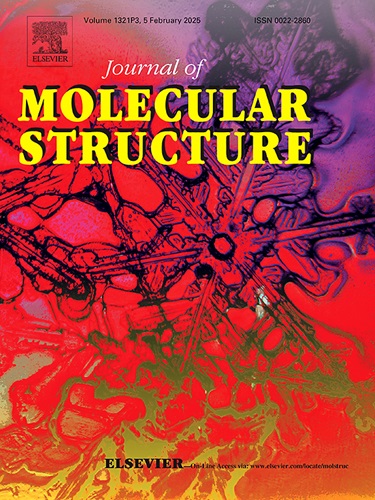Synthesis, crystal structure, DNA interaction and anticancer activity of novel organotin cinnamate complexes
IF 4
2区 化学
Q2 CHEMISTRY, PHYSICAL
引用次数: 0
Abstract
Four dibutyltin cinnamate complexes (1a∼4a) and four tricyclohexyltin cinnamate complexes (1b∼4b) were successfully synthesized and were characterized by various techniques including Fourier-transform infrared spectroscopy (FT-IR), multinuclear nuclear magnetic resonance (1H, 13C, and 119Sn), and thermogravimetric analysis (TGA). The crystal structures of these eight complexes were thoroughly determined. Among them, the dibutyltin cinnamate complexes (1a∼4a) exhibited a tetranuclear trapezoidal structure, while the tricyclohexyltin cinnamate complexes (1b∼4b) displayed a monomeric structure. The supramolecular structures were observed in 1b, 3a, 3b, 4a, and 4b All complexes were tested for their inhibitory activity against human cell lines A549, HepG2, and MDA-MB-231. The results showed that the 4a complex demonstrated the most significant inhibitory effect on HepG2 cells, with an IC50 value of 0.08 ± 0.02 μM. Preliminary studies indicated that complex 4a induced apoptosis in HepG2 cells, accompanied by G2 phase cell cycle arrest. The DNA binding activity of 4a was investigated using ultraviolet-visible, fluorescence competition assays, and molecular docking, revealing that 4a can effectively intercalate the DNA groove.
新型肉桂酸有机锡配合物的合成、晶体结构、DNA相互作用及抗癌活性
成功合成了4个肉桂酸二丁基锡配合物(1a ~ 4a)和4个肉桂酸三环己基锡配合物(1b ~ 4b),并通过傅里叶变换红外光谱(FT-IR)、多核核磁共振(1H、13C和119Sn)和热重分析(TGA)等多种技术对其进行了表征。对这8种配合物的晶体结构进行了全面测定。其中,肉桂酸二丁基锡配合物(1a ~ 4a)为四核梯形结构,而肉桂酸三环己基锡配合物(1b ~ 4b)为单体结构。在1b, 3a, 3b, 4a和4b中观察到超分子结构,并检测了所有复合物对人细胞系A549, HepG2和MDA-MB-231的抑制活性。结果表明,4a复合物对HepG2细胞的抑制作用最为显著,IC50值为0.08±0.02 μM。初步研究表明复合物4a可诱导HepG2细胞凋亡,并伴有G2期细胞周期阻滞。利用紫外可见、荧光竞争和分子对接等方法研究4a的DNA结合活性,发现4a能有效嵌入DNA凹槽。
本文章由计算机程序翻译,如有差异,请以英文原文为准。
求助全文
约1分钟内获得全文
求助全文
来源期刊

Journal of Molecular Structure
化学-物理化学
CiteScore
7.10
自引率
15.80%
发文量
2384
审稿时长
45 days
期刊介绍:
The Journal of Molecular Structure is dedicated to the publication of full-length articles and review papers, providing important new structural information on all types of chemical species including:
• Stable and unstable molecules in all types of environments (vapour, molecular beam, liquid, solution, liquid crystal, solid state, matrix-isolated, surface-absorbed etc.)
• Chemical intermediates
• Molecules in excited states
• Biological molecules
• Polymers.
The methods used may include any combination of spectroscopic and non-spectroscopic techniques, for example:
• Infrared spectroscopy (mid, far, near)
• Raman spectroscopy and non-linear Raman methods (CARS, etc.)
• Electronic absorption spectroscopy
• Optical rotatory dispersion and circular dichroism
• Fluorescence and phosphorescence techniques
• Electron spectroscopies (PES, XPS), EXAFS, etc.
• Microwave spectroscopy
• Electron diffraction
• NMR and ESR spectroscopies
• Mössbauer spectroscopy
• X-ray crystallography
• Charge Density Analyses
• Computational Studies (supplementing experimental methods)
We encourage publications combining theoretical and experimental approaches. The structural insights gained by the studies should be correlated with the properties, activity and/ or reactivity of the molecule under investigation and the relevance of this molecule and its implications should be discussed.
 求助内容:
求助内容: 应助结果提醒方式:
应助结果提醒方式:


